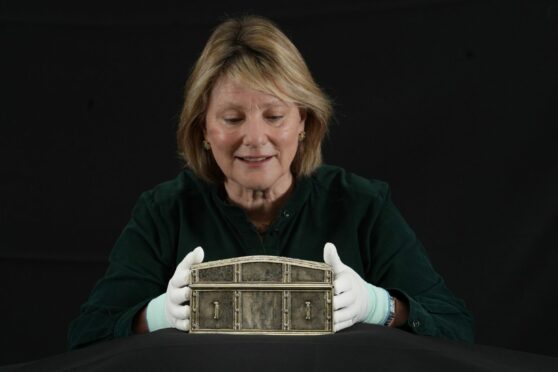
A silver casket said to have belonged to Mary, Queen of Scots is finally giving up its secrets.
The “extraordinary” casket, around the size of a shoebox, has gone on display at the National Museum of Scotland (NMS) after it was saved for the nation. Made in Paris around 1500, it is thought to have been given to Mary by her first husband, François II of France, and came to Scotland with her in 1561.
It is reputed to have later contained the so-called “casket letters” – the letters and love poems allegedly from Mary to her third husband, the Earl of Bothwell, that were used in 1568 to implicate them both in the murder of Mary’s second husband, Lord Darnley.
Although many experts believe the letters were doctored, they are said to have been key to Mary spending the final 19 years of her life held captive in England. The casket was acquired by Anne, Duchess of Hamilton, from the Douglas family around 1674, and is inscribed with the Hamilton family crest. However, the casket that contained the damning letters presented to Queen Elizabeth I in 1568 is recorded as having had François II’s coat of arms inscribed on it. Experts at the National Museum of Scotland will now use scanning techniques to discover evidence of earlier inscriptions.
Dr Anna Groundwater, the museum’s principal curator of renaissance and early modern history, said that a provenance note kept within the casket since the 17th Century states it was once inscribed with the Douglas arms, but that the Duke of Hamilton ordered it to be replaced with his own. She said: “The arms that are engraved on the casket at the moment are those of the dukes of Hamilton – you can see the birlinn or galley ship and the three cinquefoils in the other quarters.
“We can see that underneath the Hamilton arms there have been other things engraved so that agrees with the note in that there was something there before that was erased.
“We will be doing scientific analysis to determine what was there before. Our conservation lab can use hi-res scanning equipment to reveal incredibly detailed images so that any dent – in fact, any incision at all – on the surface, will come out in the relief.”
Why there is still something about Mary: Experts on how iconic Queen of Scots continues to fascinate
National Museums Scotland bought the casket from Lennoxlove House, which is located on the outskirts of Haddington and its owner since the middle of the 20th Century, for £1,789,834. Curators say it ranks among the nation’s most important historic treasures, such as the Honours of Scotland and the Declaration of Arbroath.
There were fears that had it not been purchased for the national collection, it might have been lost to Scotland forever. Dr Groundwater said: “This casket is probably the biggest thing I will ever deal with in my career. We know that it was made in Paris between 1493 and 1510. We can’t find any comparators that still exist in Europe because, in the 17th Century, Louis XIV ordered silver to be melted down to pay for his wars.
“In public ownership, I cannot think of anything more certainly associated with Mary, Queen of Scots that is of any greater importance. If we hadn’t bought it we would be terrified of it going abroad.”

Enjoy the convenience of having The Sunday Post delivered as a digital ePaper straight to your smartphone, tablet or computer.
Subscribe for only £5.49 a month and enjoy all the benefits of the printed paper as a digital replica.
Subscribe